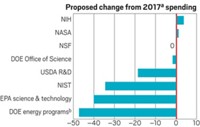Advertisement
Grab your lab coat. Let's get started
Welcome!
Welcome!
Create an account below to get 6 C&EN articles per month, receive newsletters and more - all free.
It seems this is your first time logging in online. Please enter the following information to continue.
As an ACS member you automatically get access to this site. All we need is few more details to create your reading experience.
Not you? Sign in with a different account.
Not you? Sign in with a different account.
ERROR 1
ERROR 1
ERROR 2
ERROR 2
ERROR 2
ERROR 2
ERROR 2
Password and Confirm password must match.
If you have an ACS member number, please enter it here so we can link this account to your membership. (optional)
ERROR 2
ACS values your privacy. By submitting your information, you are gaining access to C&EN and subscribing to our weekly newsletter. We use the information you provide to make your reading experience better, and we will never sell your data to third party members.
Research Funding
U.S. Congress passes 2019 budgets for some science agencies
NIH, defense, energy receive funding increases, while NSF, NIST, EPA, and others await final approval in December
by Andrea Widener
October 5, 2018
| A version of this story appeared in
Volume 96, Issue 40

Several major U.S. science agencies, including NIH and the Departments of Defense (DOD) and Energy (DOE), will see increased funding in fiscal 2019. But not all agencies know their financial fate yet. Many funding bills are still outstanding, including for major research supporters and environment regulators like NSF, NIST, NASA, and EPA.
“The fact that we are not shut down or punting out to next year is an achievement,” says Anthony Pitagno, director of government affairs for the American Chemical Society. ACS publishes C&EN.

Congress passed and President Trump signed five of the 12 appropriations bills that compose the 2019 U.S. federal budget. But several science agencies will have to wait until December to know what their future holds. Those agencies include EPA, NASA, NIST, NSF, and USDA.
a Advanced Research Projects Agency-Energy b Includes renewables, energy efficiency, nuclear energy, fossil fuels, grid research, and cybersecurity.
Source: AAAS R&D Budget & Policy Program
In the waning days of September, Congress passed and President Donald J. Trump signed five appropriations bills. “Most of the last several years there haven’t been any spending bills adopted on time,” explains Matt Hourihan, director of the American Association for the Advancement of Science’s R&D Budget & Policy Program.
That’s good news for those agencies who learned their funding amount before the fiscal year started Oct. 1, and it helps them ensure stable financial support to internal scientists and external grantees. The remaining agencies are operating on a continuing resolution until Dec. 7 or beyond. That will keep their funding at 2018 levels until after the midterm congressional elections.
The increased funding across the board is a big change from what the Trump administration wanted. “The administration proposed a budget that is draconian for science, and Congress ignored that,” Pitagno says.
NIH continued its strong support from Congress, receiving a $2 billion increase from 2018 to $39 billion. This is the fourth $2 billion increase in a row for NIH, Hourihan says. “More and more, it looks like several years of stagnating budgets at NIH seem to be an outlier.”
Science and technology at DOD got a 7.6% boost to $16 billion. The DOE Office of Science saw a 5.2% increase to $6.6 billion, and its energy office went up too. Trump had proposed killing the Advanced Research Projects Agency-Energy, but it got a 3.6% increase to $366 million.
Many of the agencies whose funding bills haven’t passed yet have reason to be optimistic about their 2019 budgets, Hourihan says. For example, NSF’s and NASA’s numbers coming out of congressional committees showed an increase. Environmental agencies, including EPA, are most likely to get cuts, he says.
Pitagno points out that while the U.S. budgets are not as low as the Trump administration had proposed, they are not keeping up with the U.S.’s competitors. “Globally, we are still falling behind,” he says.




Join the conversation
Contact the reporter
Submit a Letter to the Editor for publication
Engage with us on Twitter